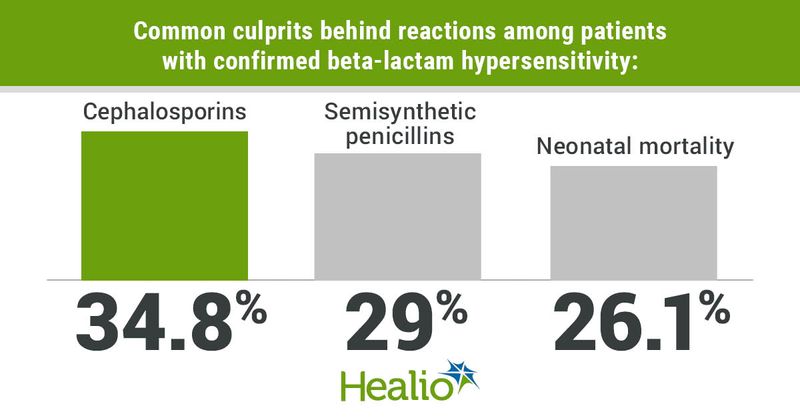Beta-lactam hypersensitivity primarily caused by cephalosporins
Click Here to Manage Email Alerts
Cephalosporins appeared to be the leading causes of beta-lactam hypersensitivity, especially in reactions that are not mediated by IgE, according to a study published in Annals of Allergy, Asthma & Immunology.
But patterns differ between patients in hospitalized and ambulatory settings, Yuda Chongpison, PhD, MS, MBA, epidemiologist and biostatistician of the skin and allergy research unit at Chulalongkorn University, Bangkok, and colleagues wrote.

The study involved 357 patients (mean age, 52.3 ± 18.8 years) with a presumed diagnosis of beta-lactam hypersensitivity (BLH), including 223 (62.5%; mean age, 49.8 ± 18 years) from an ambulatory setting and 134 (37.5%; mean age, 56.3 ± 19.5 years) who were hospitalized. In addition to being older, the hospitalized group had more underlying malignancies and fewer allergic diseases than the ambulatory group.
Natural and semisynthetic penicillins were the most commonly implicated drugs in BLH in the ambulatory group, whereas cephalosporins and carbapenems were the main implicated drugs in the hospitalized group.
Also, 45.9% of the reactions in the ambulatory group and 14.5% of those in the hospitalized group reported a suspected IgE-mediated reaction to beta-lactam antibiotics.
Testing results
There were 335 patients with 381 reactions to beta-lactams who agreed to participate in further investigation including skin prick tests, intradermal tests, skin patch tests, measurements of specific IgE antibodies, basophil activation tests, measurements of interferon-gamma releasing cells and drug provocation tests (DPT).
According to the researchers, 18.9% of all reactions were severe cutaneous adverse reactions, and 14.6% of the combined skin and in vitro tests were positive.
Specifically, 14.6% of the 41 participants with a history of an immediate reaction to penicilloyl G and amoxicilloyl tested positive for sIgE antibodies to these drugs.
DPTs among 137 patients with 144 reactions yielded 14 (9.7%) positive results, including three patients with urticaria, two with fixed drug eruption and two with maculopapular exanthems, meaning that 90.3% of those who underwent DPT saw their BLH de-labeled. Between 2 and 8 hours after drug challenges, five patients developed anaphylaxis and two developed serum sickness-like reactions (SSLR).
Of all 381 reactions, there was a 15.7% rate of positive results from in vivo and in vitro tests combined including direct DPT, and 18.1% had their BLH confirmed.
Sixty-three patients with confirmed BLH experienced 69 reactions, including 33 IgE-mediated and 26 cell-mediated reactions, most commonly due to cephalosporins (34.8%), semisynthetic penicillins (29%), natural penicillins (26.1%) and carbapenems (10.1%).
Factors predicting BLH
Among 199 reactions in 185 patients with verified BLH status, BLH appeared significantly associated with new generations of beta-lactams including cephalosporins and carbapenems, hospitalization, allergic histories of a year or less and underlying malignancies or autoimmune diseases.
BLH was 3.7 (95% CI, 1.8-7.3) times more likely among hospitalized vs. ambulatory patients and 5.3 (95% CI, 1.3-21.3) times more likely among those with vs. without malignancy.
When examining 63 patients with 69 verified beta-lactam allergic reactions, the researchers found an increased risk for hypersensitivity type IV reactions in hospitalized vs. ambulator settings (OR = 9.7; 95% CI, 3.1-30.3).
After adjusting for HIV infection status, the researchers also found that patients with underlying autoimmune diseases experienced increased risks for non-type 1 and IV reactions including delayed anaphylaxis, serum sickness and SSLR (adjusted OR = 5.3; 95% CI, 1-27.9).
Based on these findings, the researchers concluded that cephalosporins and other beta-lactams from newer generations were more likely to have an increased risk for BLH, with different hypersensitivity patterns in hospitalized and ambulatory settings.
They also concluded that current approaches for BLH de-labeling do not apply to high-risk patients with contraindications for DPT, whereas combined in vivo and in vitro techniques would be more appropriate in hospitalized settings, although other novel modalities for identifying culprit drugs should be explored as well.
